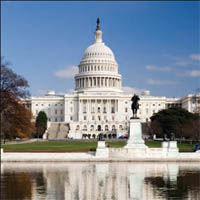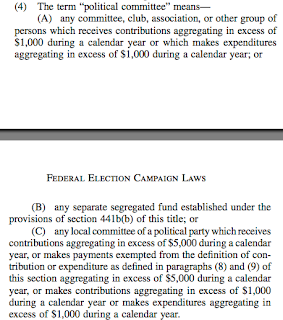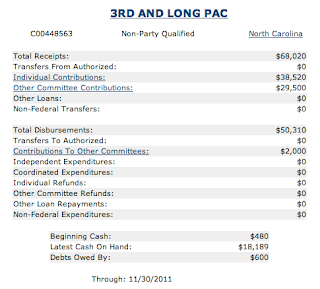
 In yesterday’s posting, I noted how difficult it was to track donated money within the political system of the United States. Despite the efforts of the Federal Election Commission (FEC), the very existence of thousands of Political Action Committees (or PACs) makes it nearly impossible to follow a dollar within the system. In this posting, I’d like to illuminate the issue in more detail. For source material, I am using the OpenSecrets.org website and the Federal Election Commission website.
In yesterday’s posting, I noted how difficult it was to track donated money within the political system of the United States. Despite the efforts of the Federal Election Commission (FEC), the very existence of thousands of Political Action Committees (or PACs) makes it nearly impossible to follow a dollar within the system. In this posting, I’d like to illuminate the issue in more detail. For source material, I am using the OpenSecrets.org website and the Federal Election Commission website.Let’s open by explaining PACs to those of my readers that are not American. PACs are private groups that are organized to elect political candidates of any given political persuasion. Here is a screen capture from the Federal Election Campaign Act outlining what a PAC is:
Basically, when a corporation or organization wishes to donate to a political party or candidate, they must do so through a PAC since the aforementioned are not allowed to directly contribute since it would be seen to be a conflict of interest or a form of bribery (not that PACs aren’t, it’s just legal that way!). In the case of corporate PACs, various corporations will raise money from their employees or shareholders in an attempt to ultimately further their particular cause once the party or candidate they have chosen to back financially is elected. In the case of organizational PACs, individuals that support a particular social cause may choose to donate to a like-minded PAC that will promote their beliefs.
From United States Census Bureau data, here is a screen capture showing the growth in the number of PACs since 1980:
PACs account for less than 30 percent of all contributions in United States Congressional elections and less in Presidential elections, nonetheless, they are an extremely important fundraising mechanism. Here is a screen capture from the Census Bureau showing how much was raised by all PACs in the years from 2003 to 2008 by type of PAC:
That’s a whopping $1.212 billion raised in 2007 – 2008 alone. That’s a lot of lawn signs, television and newspaper advertising!
Here is a screen capture from Open Secrets showing just how much money the top 20 PACs contributed to candidates in the 2007 – 2008 election cycle:
It is interesting to see that there is a very, very wide range of interest groups in the top 20, mostly industrial or financial in nature, that wish to "bend the ear" of those dwelling in the ivory towers of Washington. Who says money can’t buy influence?
Here are the top 20 PACs thus far in the 2011 – 2012 election cycle, remembering that we are still very early in the cycle:
As noted in the screen capture at the beginning of this posting, under Federal law, PACs are allowed to contribute up to $5000 to a candidate committee once per election, up to $15,000 annually to a national party committee and $5000 annually to another PAC. However, there is no limit to how much PACs can spend on advertising in support of their candidate or in opposition to those running against their chosen candidate.
Now, let’s get to the purpose of this posting. According to Open Secrets, the sixth largest PAC during the 2010 election cycle was the American Bankers Association (ABA). The ABA represents banks of all sizes and is "…the voice for the nation’s $13 trillion banking industry and its 2 million employees". Hereis a historical look at what the ABA has raised and donated since 1990 focusing on how much they raised and spent in 2010:
The ABA doled out 32 percent of their support to the Democrats and 67 percent to the Republicans in 2010.
Now, let’s flip to the information available on the FEC website. Here’s a summary of the ABA’s funding for the most recent election cycle:
If we click on the "Contributions to Other Committees" link, it takes us to a listing of all the Committees that the American Bankers Association contributed to. It is a rather massive list, isn’t it? I picked out one of the Committees, the rather interesting sounding "Blue Dog Political Action Committee" and dug a bit deeper. Blue Dog received $5000 from the ABA in 2011. Here’s what Blue Dog has been up to during the most recent cycle according to Open Secrets:
Notice that 100 percent of their support in their last report of 2011 went to Democrats. Back in 2010, 99 percent of their donations went to the Democrats. That’s quite a different story than one would think from the contributions that were made by the American Bankers Association who gave only 32 percent to the Democrats in 2010, isn’t it?
Now, let’s continue to follow the bouncing buck by looking through the list of the Committees that Blue Dog PAC donated to. Right at the very top, we find the "3rd and Long PAC". This small, North Carolina-based PAC received $5000 from the Blue Dog PAC in 2011. Here is the summary report from the FEC for the 3rd and Long PAC:
Now, let’s see where 3rd and Long spent its money this year:
Ms. Giffords (D – Arizona) and Mr. Heinrich (D – New Mexico) both received $1000 from 3rd and Long in 2011. That’s 100 percent to the Democrats in 2011 and only three degrees of separation from the original American Bankers Association PAC.
Now you can see just how difficult it is to follow any donated dollar through the system. With PACs so strongly interlinked, it is nearly impossible for Main Street Americans to learn who they are ultimately supporting, should they choose to donate to a PAC. As well, while PACs can be useful in bringing together like-minded individuals that wish to promote their particular cause, why should it be necessary for voters to donate to any party or candidate to have their voice heard (he said naively)? After all, every vote should be equal, unfortunately, as we all know, that is far from the case. It is the moneyed voices who speak the loudest in American politics. Perhaps it’s just easier for us to think of PACs as a legal form of bribery.
Click HERE to read more of Glen Asher’s columns.
Article viewed on Oye! Times at www.oyetimes.com
You can publish this article on your website as long as you provide a link back to this page.











Be the first to comment